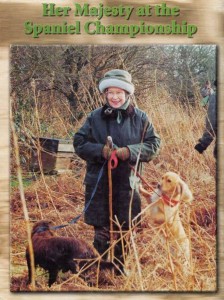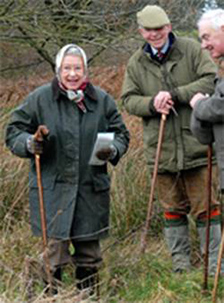Get a “Hold” On It
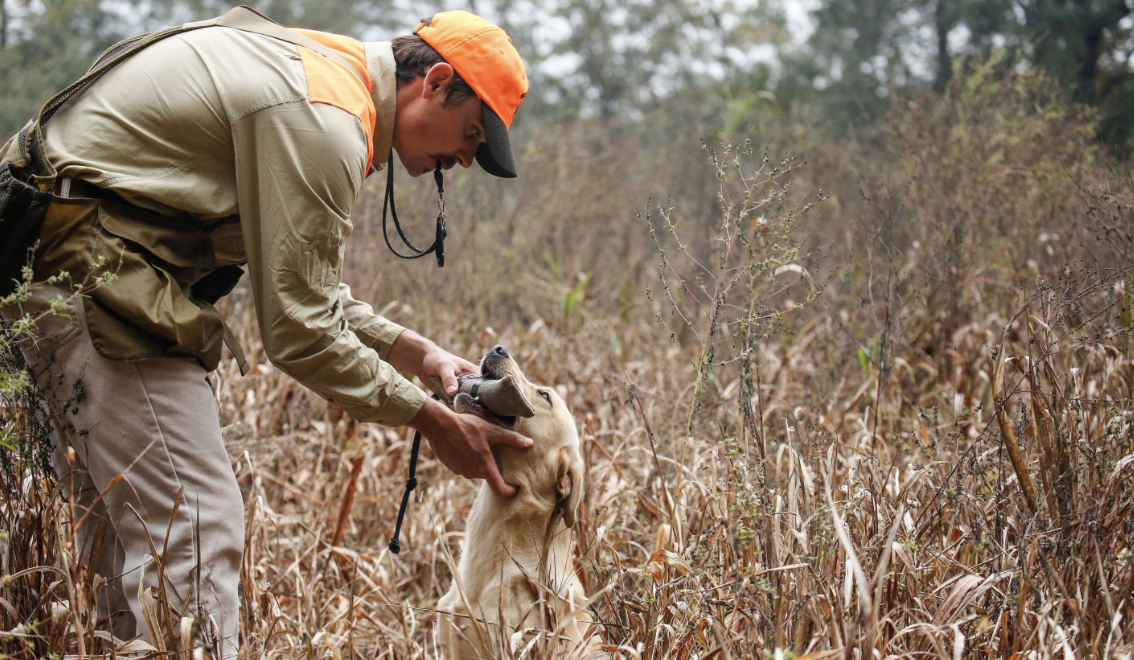
It is expected that a properly trained gundog brings back birds, preferably uneaten, and delivers them to hand. Game recovery remains a high priority of the retriever and making solid deliveries is a requirement.
Delivery Desirables:
· No occasional dropping of the bird.
· No dropping to shake at the water’s edge.
· No playing with the bumper or bird.
· No chewing, mouthing, chomping, or crushing of any retrieved object.
· No plucking of a bird afield.
· No dropping at the handler’s feet.
Delivery Expectations:
· A clean, fast pickup of the object
· Return directly without dropping.
· No mouthing or hard mouth in the process
· Holding the object until the hand accepts the item and the command to release is given.
· A direct delivery from pickup to hand of an undamaged bird. No frolicking about in route.
The issue I continue to observe in dogs coming for basic training, returning for advanced or pre-season tune-ups, and participating in workshops is mouth and delivery problems. This is too important an issue to ignore so it is time to address the problems.
It’s always best to avoid dysfunctional delivery habits altogether but problems are obviously persisting. So, we will look at the topic from three categories, each presenting its own challenges:
1. Pregame – before basic training, puppy backgrounding
2. Game Day – hold conditioning during basic training
3. Post Game – maintaining expectations after basic graduation
Pregame – Puppies (8 weeks to 7 months of age), The early days of backgrounding where learned behaviors develop into enduring habits.
Please practice Wildrose Law #4 – Don’t condition in a problem that must be trained out later.
Puppies are learning sponges. They are developing behaviors that will likely endure into adulthood, whether desirable or dysfunctional. Keep this in mind… If a young pup repeats an enjoyable behavior with consistency, the behavior will likely become an entrenched habit. You own it!
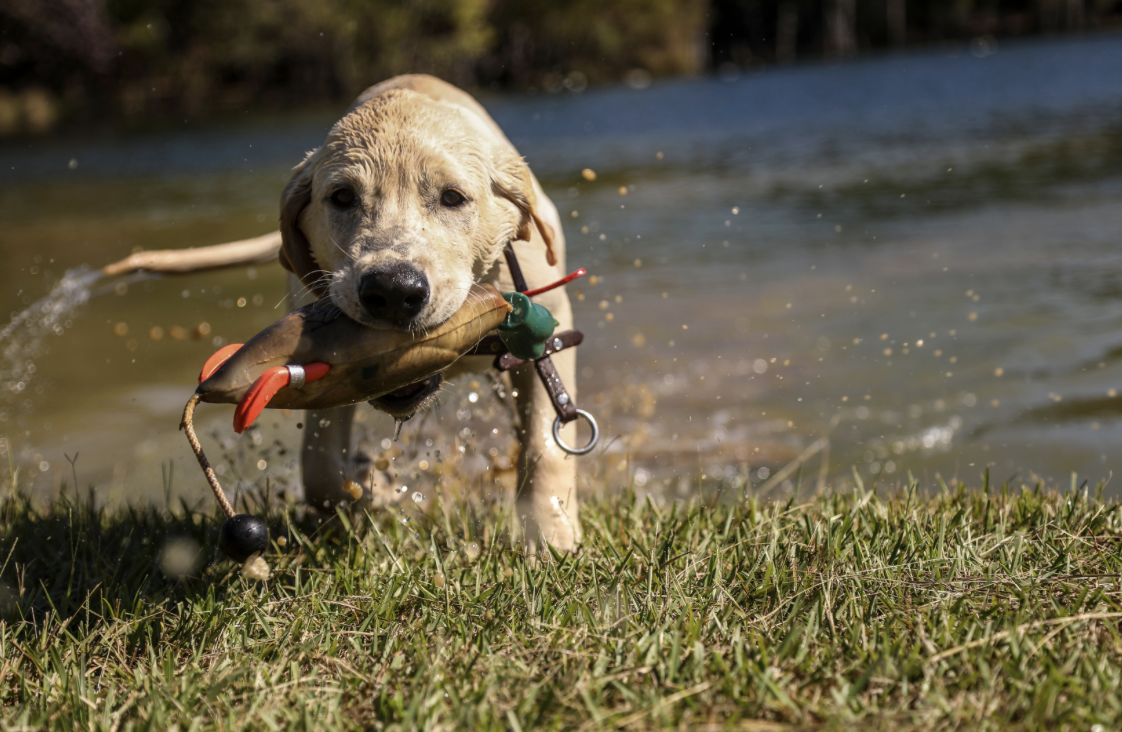 I realize the following list of tips may be redundant for many of our readers. (you may be thinking, “I’ve heard this before.”) If so, I have a question that needs to be answered, “If understood, WHY do so many of our followers continue committing these listed dysfunctional practices?” People continue to put in problems in their pups that must be eliminated later, time and time again. WHY?
I realize the following list of tips may be redundant for many of our readers. (you may be thinking, “I’ve heard this before.”) If so, I have a question that needs to be answered, “If understood, WHY do so many of our followers continue committing these listed dysfunctional practices?” People continue to put in problems in their pups that must be eliminated later, time and time again. WHY?
Therefore, the first step to improve a dog’s delivery will be to address What Not to Do with a pup, 8 weeks to 7 months of age. The No-No list of violations of the Wildrose Way for pups includes:
1. No chew toys, possessions, squeaky objects, chew bones…EVER!
2. No playing chase especially with an object in the pup’s mouth.
3. No edible treat delivery from anyone’s hand.
4. No chewing, mouthing, or licking of anyone’s hands.
5. No chewing of objects picked up such as sticks, bumpers, clothing articles, leads, etc. Just gently take the item away.
6. No free romping with a ball or bumper which can foster indirect returns, dropping, chewing, or toying with the object.
7. No scuffling with other dogs or kids over an object. Think “dog park frolicking or tug-of-war.”
8. No overuse of cold game birds or feather-laced bumpers at an early age. Bird introductions are ok in controlled spaces but chomping, chewing, or plucking is not allowed. STOP!
9. No allowing the pup when retrieving to drop the bumper at your feet. Get it fast in hand.
To conclude our pre-game category to promote solid delivery is to think about “an ounce of prevention” in every interaction with our pups.
Game Day: Basic Retriever Training
Basic retriever training has 7 primary parts, one of the most important is hold conditioning…. delivery to hand. We begin formal basic training with a puppy at about 7 months of age. After ensuring our student is enthusiastic about retrieving or at least going out for an object, we can begin hold conditioning, usually at about 8 months.
The Wildrose method of conditioning delivery is not with the use of force fetch. It’s a blend of shaping and rewarding the desirable “hold” behaviors through praise and our unique massage technique. The method is explained beginning on page 118 of Sporting Dogs and Retriever Training, the Wildrose Way and can be viewed on our Basic Gundog DVD which is now downloadable to the mobile platform of your choice as is our book mentioned above. Both are available at wildrosetradingcompany.com.
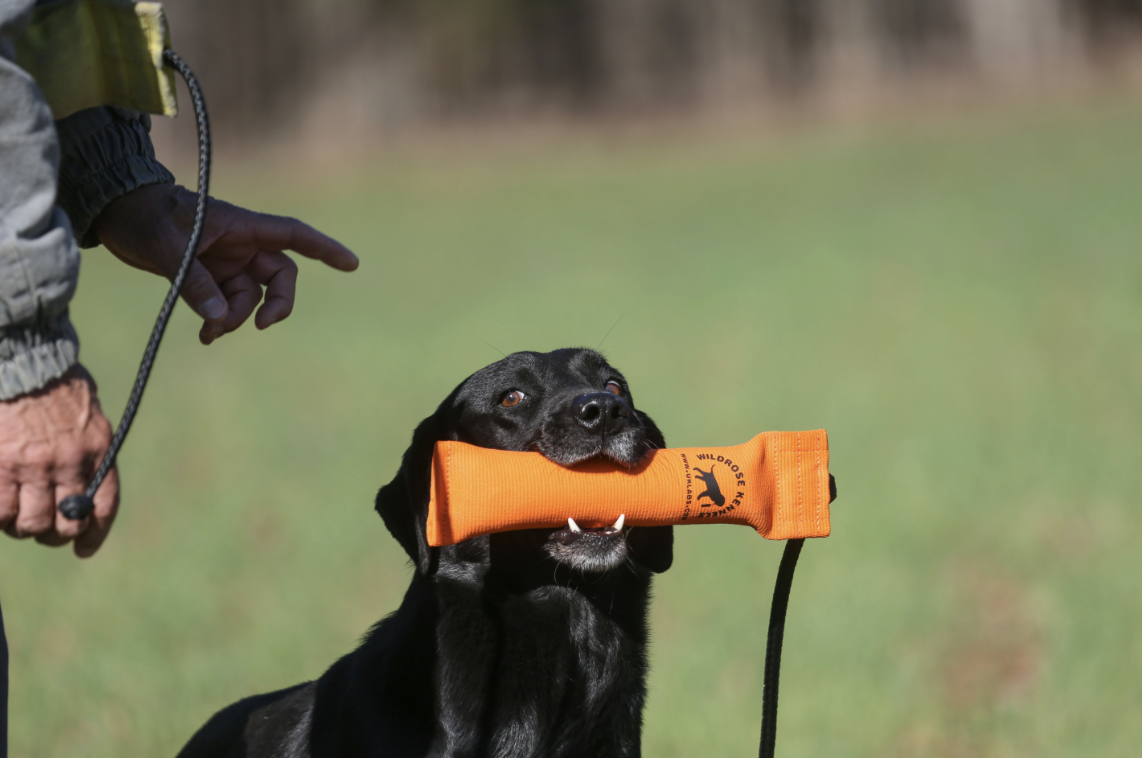 In addition to the lessons available through both resources, here are a few tips that are important to the development of Delivery to Hand.
In addition to the lessons available through both resources, here are a few tips that are important to the development of Delivery to Hand.
· We are teaching three commands in the process:
1. Fetch – to accept the object.
2. Hold – to securely grasp the object and not chew.
3. Release – to give the object to hand on command.
· During hold conditioning, stop all retrieving.
· During hold training, practice recall to the handler, negotiating cover and obstacles, and presenting their muzzle to the handler as their hand reaches toward the dog. We want to condition a direct return when the dog is called and a proper presentation to the handler’s hand.
· When practicing holding an object, get it right on land before going to the water.
· Do not rush the process. Ensure each step is completed before moving to the next. No skipping steps or rushing.
· Three lessons to include in hold conditioning while your dog is carrying an object:
1. Entering and exiting the water.
2. Negotiating obstacles: under a fence, up a ramp, jumping an obstruction, entering a hide, moving through thick cover, etc.
3. Using a partially frozen bird while practicing hold and recall. Cold game should be the final step.
· Limit hold lessons to 5 successful repetitions per session. Do not bore the dog.
· Conduct sessions when the dog is alert and enthusiastic and not overheated. Panting is not conducive to the process.
· Do not lose patience, show frustration, or become angry. End on a win and reward small improvements as progress is made. Make haste slowly.
Post Game – After Graduation – the Standards Must Remain
The desirable delivery-to-hand behaviors entrenched in basic gundog are standards that should be maintained throughout the dog’s life. Be aware during training and daily activities of the dog’s delivery. Do not allow proper delivery skills to fade and diminish. Usually, this erosion is a result of the owner and the family not maintaining the standards of basic gundog training whether it’s whistle response, steadiness, or delivery.
Sloppy delivery becomes acceptable due to inattention, lack of work, laziness, or ignoring minor infractions such as chewing, dropping on returns, or not holding at delivery until the command to release is given. These become habits the dog gets away with. Simply, the standards are not maintained by the handler when training afield, on exciting hunts or around the home when active with the family.
Just this summer, I experienced these very conditions with some dogs arriving for training at Wildrose Colorado which prompted me to write this article:
1. Mouthing/chomping at delivery
2. Dropping on the return repeatedly
3. Dropping at my feet at point of delivery
4. Quick release as I reached for the bumper
5. Mouthing feather-laced bumpers
6. Chomping tennis balls
7. Dropping to shake when exiting water
8. Dropping frequently while moving through obstructions such as weeds and light brush
9. A young pup with mouthing problems resulting from chew toys and treats from the hand
All but number 9 had basic training experience in the past and were in for advanced work.
What’s To Be Done?
Problem 1 – Dropping to shake at water’s exit: Get in shallow water yourself. Reinforce delivery by accepting the retrieve just as the dog returning regains footing while still in the water. Praise a few successes then gradually back toward the bank. Continue backing out at the water’s edge praising the hold.
Problem 2 – Dropping at delivery. Reinforce the “hold” command while sitting, heeling, and then recall. Accept the retrieve in front requiring the dog to hold firmly until the object is grasped. Wait momentarily holding the object in hand before giving the command to release.
Problem 3 – Dropping while running through high cover. Practice hold recall and heel work in tall cover with the dog carrying a long object pushing through cover without dropping. With my dog Pappy I used a 3-foot beaver-cut willow stick. While holding the object he learned to avoid solid obstacles and push through thick grass and light brush carrying the stick at heel and recall without dropping.
Problem 4 – Mouthing tennis ball. The balls are great for hunting and scent work but often dogs do chomp them a bit. Just use a larger tennis ball that can be acquired at Tractor Supply and pet stores or switch to a Wildrose puppy bumper as it, too, is small for hunting and holds scent well.
STOP! If you don’t maintain proper behaviors desired in the field, marsh, or trail, they will fade, that is erode, and new less-impressive behaviors will develop.
If sporting dog excellence is valued, then the three categories of delivery must be embraced:
Pre-Game – avoid mistakes in puppyhood.
Game On – train proper delivery to hand to the point of a predictable habit.
Post Game – maintain the standards.
Parting thought:
A novice trains until he/she gets it right. A professional trains until he/she can’t get it wrong.
Train like a Pro with the Wildrose Way!
Mike Stewart
Cathy@uklabs.com


